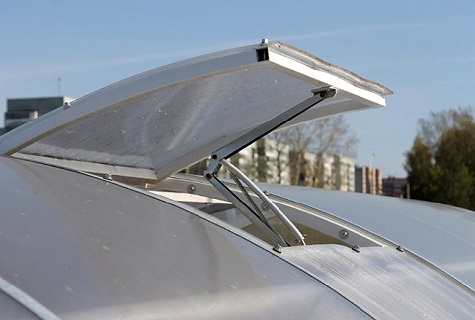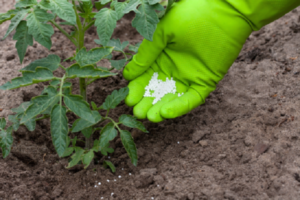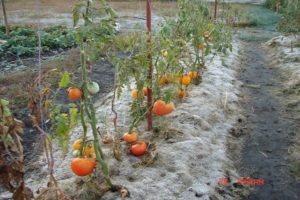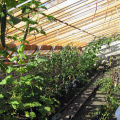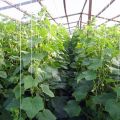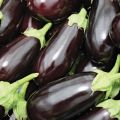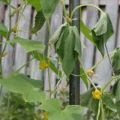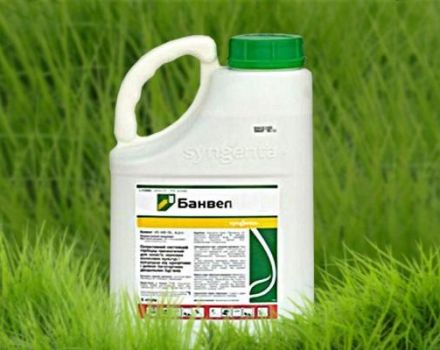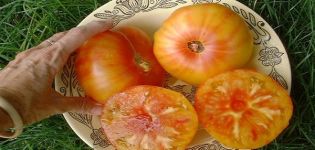Do-it-yourself automatic greenhouse watering system
Almost any gardener has a moment when there is a desire to do automatic watering in the greenhouse with his own hands. This desire is easy to explain. In summer, in addition to the vegetable garden, there are many exciting activities for which you need to leave your country house, or which do not allow you to come to the country. Cucumbers and tomatoes planted in a greenhouse, left unattended, can lose color from a lack of moisture, get sick or simply die. Automation of irrigation will eliminate the need to fiddle with hoses, automatic irrigation will save the summer resident strength and reduce water consumption.
Content
- 1 Types of irrigation systems for summer cottages and their features
- 2 All about the organization of drip irrigation
- 3 Draw a greenhouse diagram
- 4 Mounting
- 5 Drip irrigation and its benefits
- 6 Sprinkler irrigation
- 7 Underground irrigation system
- 8 Equipment for automatic irrigation systems
- 9 Pumps and filters
- 10 Automatic ventilation of the greenhouse
Types of irrigation systems for summer cottages and their features
It is necessary to consider all the currently popular automatic irrigation schemes, before you start creating automatic irrigation in your greenhouse. In the form of an enlarged diagram, any irrigation system consists of the following parts:
- source;
- equipment for forced water supply under pressure;
- water purification systems from mechanical, chemical and other impurities;
- automation (controller);
- pipes and valves.
All about the organization of drip irrigation
Drip irrigation in a polycarbonate greenhouse is the dream of every summer resident. Large containers (metal or plastic barrels) are usually used for water. A barrel (tank) is a source of water. For better water heating and pressure creation, the tank must be raised above the ground. The number of bars (pipes) required for the construction of a support for the tank is calculated based on the size of the tank (tank) and its height above the ground. The recommended height for a pressure of 0.2 atmospheres is 1 m or 2 m.
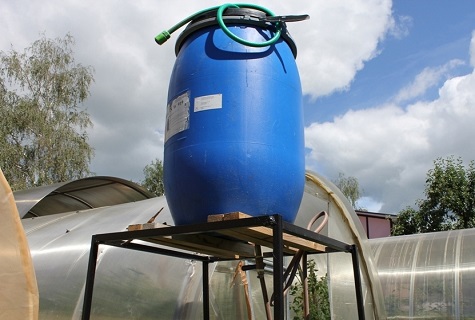
To create automatic drip irrigation in a greenhouse, pipes are needed. Through pipes, water from a natural reservoir or central water supply is supplied to the barrel. You can use plastic or metal pipes. It is more profitable to use plastic pipes, since they do not corrode, serve for a long time, and are easy to install.
To supply water, a pump is installed, if there is already an operating pumping station in the country, then the container is connected to it using pipes.
It is imperative to include a cleaning system in the scheme - a filter for coarse water purification from mechanical impurities. The filter is installed at the outlet of the barrel, next to the ball valve. A controller with an electromechanical valve must be installed behind the filter. Thanks to the controller and the valve, water will be automatically supplied (turned off).

Draw a greenhouse diagram
Before purchasing greenhouse equipment, you need to make a greenhouse drawing.On the diagram, indicate not only the dimensions of the greenhouse itself, but also the size and location of the ridges. The drawing is needed to calculate the required line length, the number of branch fittings, the length of the drip tape or, if you decide to use droppers, the length of the hose and the number of droppers.
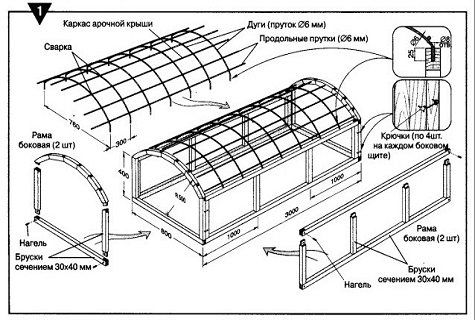
Mounting
Begin installation by laying the main hose (pipe), the recommended pipe diameter is 40 mm. It is better to place the central highway at a slight angle to the horizon. When storing the system for the winter, it will be easier to drain the water. You can lay the sleeve in a trench, the maximum permissible trench depth is 50 cm. With the help of a valve, the line is connected at one end to a water source, and a tap or plug is placed at the other end.
Along the entire length of the main plastic pipe, at the points of attachment of the drip tapes, holes must be drilled for mounting the start connectors. Drip tapes are unwound, laid out on ridges, fixing with holders. Attached to the central tube. It is necessary to cut the tapes with a margin (100 mm). Place plugs on the end parts. The system is washed after completion of work.
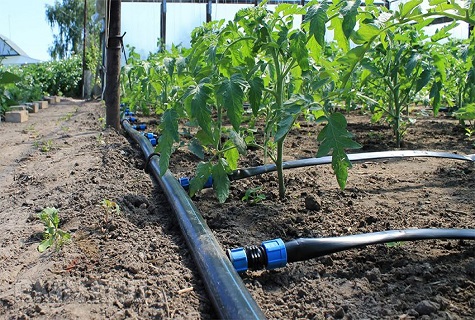
Drip irrigation and its benefits
During the operation of the irrigation system, automatic water supply will be carried out using the controller. At the signal of the controller, the electromechanical valve opens, and under a pressure of 0.2 atmospheres, the water flow passes through the central line to drip tapes, which is fed directly under the root of each plant. Instead of drip tapes, the system can be equipped with hoses and drippers.
After installing the drip system, significant water savings are noted, on average, its consumption is reduced by 30%. In a greenhouse equipped with a drip irrigation system, the incidence of tomatoes, strawberries, and cucumbers is significantly reduced. The reason is optimal soil moisture. For a greenhouse in the country, drip irrigation is a good solution.
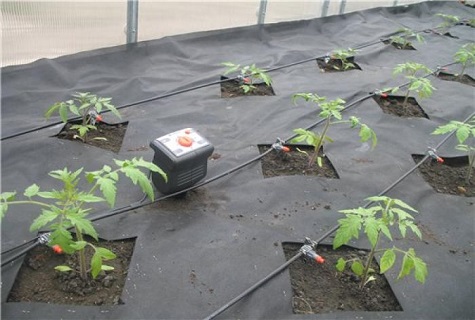
Sprinkler irrigation
In a greenhouse with automatic irrigation, the method of sprinkling can successfully grow moisture-loving crops. This type of system is suitable for cucumbers, they love moist air and no drafts. It is not difficult to assemble this model of an automatic irrigation system in your greenhouse. It is necessary to calculate the required length of pipes, the number of taps and spray nozzles.
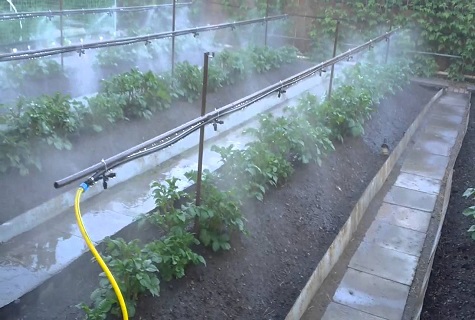
Sprayers (nozzles) cover a large radius. The piping system for the water supply is often located at the top of the greenhouse. The source is a barrel, at the output of which are installed:
- pump for supplying water under pressure;
- crane;
- filter;
- timer.
To organize irrigation by sprinkling, pipes with a diameter of 22-25 mm are suitable; they must be mounted under the roof of the greenhouse. On the one hand, the pipe is connected through the compensating loop and the coupling to the main pipe coming from the water source, on the other hand a plug is placed on the pipe. The spray nozzles are installed on the pipe with the desired pitch.

Underground irrigation system
Watering in the greenhouse can be organized by underground irrigation. To do this, you will have to work with a shovel, since the pipes are laid in trenches. With underground irrigation, water is supplied directly to the root of each plant.
The advantage of such a system is the efficient use of water, the enrichment of the soil with oxygen, and the absence of a crust. The disadvantages include the difficulty of installation associated with earthworks. Repairing such a system will also require physical effort.

For a central pipeline, a plastic pipe with a diameter of 32 to 50 mm is suitable. To supply water directly to the roots of plants, you need to use special porous hoses. It is better to dig a trench for laying the central pipe in the middle of the greenhouse, the required trench depth is 40-60 cm.
The assembly of a system consisting of plastic pipes is carried out using fittings. To supply water to the pipes, droppers or sprayers are mounted. The assembled system is poured first with a small layer of sand, on top of it - with ordinary soil.
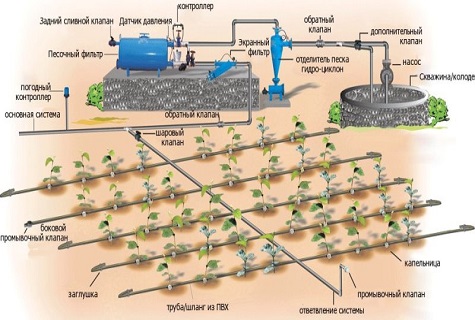
Equipment for automatic irrigation systems
To automate your greenhouse, you cannot do without special equipment for automatically supplying water from the source to the central highway. For this purpose, timers and controllers are used, both of which are equipped with solenoid valves.
Using timers, you can set the watering time and frequency. Device controllers are more complex. They are equipped with a display and a set of buttons with which you can set a specific watering program for the days of the week.
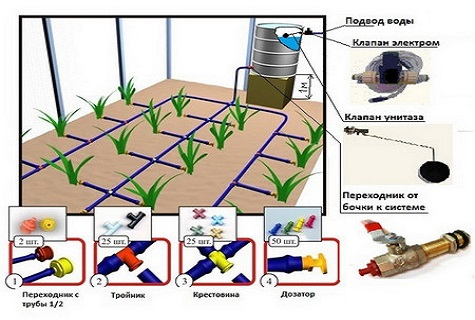
For a small greenhouse, a timer or an inexpensive controller with one channel is suitable. If there are several greenhouses, you will need a more expensive model of a multi-channel controller. Plus expensive models - GSM module and the ability to control the system using your mobile phone. An alternative to one multi-channel controller can be multiple timers (single-channel).

Pumps and filters
Watering requires settled water, therefore, a metal or plastic barrel performs not only a backup function, accumulating water. In a barrel, the water is heated to air temperature, when watering, this has a positive effect on plant health. A tap must be cut into the bottom of the barrel. A tap is needed for emergency drainage of water and for an audit: cleaning the tank from debris, rust, sediment. The water supply pipe is mounted in the upper part of the tank, the greenhouse supply pipe is located in its lower part.
There are certain criteria to be followed when choosing a pump. Purchase a pump if it meets the requirements:
- it is easy to mount and dismantle;

- there is a soft start system;
- low noise level;
- the material of the case is resistant to the effects of chemicals included in the composition of fertilizers;
- optimal power;
- the possibility of automation.
Automated watering systems for greenhouses must be equipped with high-quality filters for water purification. The reliable operation of irrigation systems will largely depend on the quality of the water used. Drip tapes fail quickly when untreated water is used. For small greenhouses with a barrel as storage, strainers are suitable.
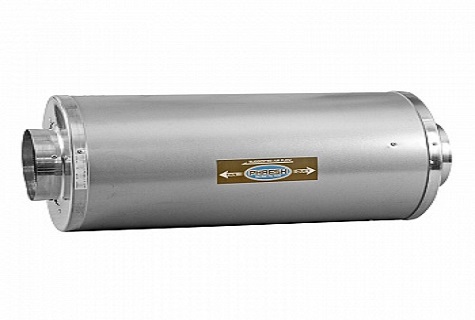
Automatic ventilation of the greenhouse
Do not dwell on the automation of irrigation in the greenhouse. For greenhouse plants, a certain air humidity and temperature regime are important. Natural ventilation with vents may not always provide the required parameters.
The problem can be solved with forced ventilation using fans installed inside the polycarbonate greenhouse. The plus of a greenhouse with automatic ventilation is obvious:
- Plants are less likely to get sick with late blight, powdery mildew.
- A certain microclimate is maintained in the greenhouse, which is necessary for greenhouse plants.
- The optimum air temperature is maintained.

Together with the fans, a thermal relay is installed in the greenhouse, they are responsible for automatically turning on and off the fans. Greenhouses with ventilation and watering greatly facilitate the work of summer residents. The yield in such greenhouses is higher, the percentage of plant diseases is lower.
